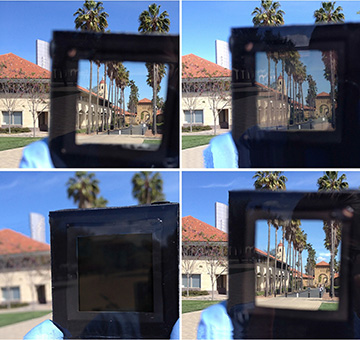
Stanford researchers have reportedly developed prototype dynamic windows that darken quickly and that are color neutral. [Image: Barile et al., Joule, doi: 10.1016/j.joule.2017.06.001]
Engineers at Stanford University, USA, have fashioned prototype dynamic windows that can go from transparent to opaque at the flip of an electrical switch—and that apparently avoid some of the pitfalls of other switchable-window approaches (Joule, doi: 10.1016/j.joule.2017.06.001). The research team believes that, with some additional tweaking, the technique will have cost and functionality advantages at scale that could help it carve out position in a market potentially worth hundreds of millions of dollars.
Energy savings
Dynamically switchable windows offer the ability to electronically control the amount of light entering a room—potentially a significant energy saver and an interesting addition to the architect and interior designer’s toolkit in the Internet of Things era. It’s been estimated that dynamic windows, by reducing heating, cooling and artificial-illumination requirements, can clip as much as 10 percent off of a building’s energy costs.
But while a number of approaches exist to create such windows, and while they have started to appear in some applications, they have yet to make significant inroads in the market. That’s partly, according to the new study’s authors, because of shortcomings—in characteristics such as durability, switching speed, color and cost—in the technologies out there.
The most promising approach, and the one on which the Stanford team has trained its sights, involves so-called electrochromic windows, which are treated with materials, such as transition-metal oxides or certain polymers, that change their optical characteristics when a voltage is applied. The system works—but the windows that result can be costly, darken very slowly (over periods of 20 minutes or more), and often have an undesirable blue tint.
Another approach, polymer-dispersed liquid crystals, can switch much faster, but scatter light in undesirable ways for some applications. And thermochromic windows, which darken with temperature changes, do not allow easy user control.
The metal advantage
The Stanford team, led by materials scientist Michael McGehee, took another look at the electrochromic approach. The researchers reasoned that the use of metals as electrochromic materials, rather than transition-metal oxides or polymers, could offer advantages: metals are sufficiently opaque that only nanometer thicknesses would be required to substantially darken a window. And metals can be color-neutral, avoiding the pitfall of undesired tinting that has undermined some other electrochromic approaches.
The researchers reasoned that the use of metals as electrochromic materials could offer advantages.
Such a window would work through an oxidation-reduction (redox) reaction, in which applying a voltage would lead to the electrochemical movement of metal ions and to reversible deposition of a thin metal film on one side of the window. But, although the chemistry sounds simple, the execution isn’t; it turns out that it’s quite difficult to fashion a system that uniformly, reversibly deposits metals on a large-area surface.
Tweaking the chemistry
The McGehee team cleared that hurdle by revisiting the basic chemistry of the electrochromic system, and tweaking it to make it easier for the metals to spread across the window. The prototype that the researchers created consists of a transparent indium-tin oxide (ITO) layer that serves as the working electrode of the system, and a transparent glass layer; the latter is ringed with a narrow copper strip that acts as a counter-electrode, and that sits beneath the window frame. Sandwiched between these layers is a copper-lead or copper-silver electrolyte gel.
In addition, the ITO electrode layer is peppered with platinum nanoparticles. That proved to be a crucial innovation, as the nanoparticles help to facilitate nucleation of the opaque copper and other metal particles across the ITO surface.
Fast and color neutral
For the prototype with the copper-lead electrolyte, when no potential difference was applied between the ITO and copper electrodes, the team measured transmission through the window at 92 percent (at a wavelength of 600 nm). When the juice was turned on and a potential difference of –0.55 V was applied, electrodeposition of copper and lead on the ITO surface evenly reduced the transmission to 18 percent in the space of 15 seconds. Boosting the deposition time to 40 seconds allowed the transmission to decrease to 1 to 2 percent, across a broad wavelength band encompassing the visible and infrared.
When the juice was turned on, electrodeposition of copper and lead on the ITO surface evenly reduced the transmission to 18 percent in the space of 15 seconds.
Applying a positive potential difference of 0.65 V quickly restored the windows to their original transmissibility—and the team found that it could repeat the cycle thousands of times, with no degradation in performance. And, the researchers stress, the spectral response was “relatively flat across all wavelengths”—that is, process was color neutral, a key point in real-world applications.
Cost advantage?
The Stanford team also sees potential cost advantages in the approach it’s developed. That’s because the films of silver and platinum in these windows are nanometers thin, requiring very small amounts of materials. “A 1-ft2 window with a 50-nm-thick layer of Ag and a 3-nm-thick layer of Pt,” the researchers write, “would contain less than $0.20 worth of Pt and less than $0.03 worth of Ag.”
The Stanford engineers have some work to do in scaling up their original 5-cm-square prototype into a working window, but they’re sufficiently confident in their ability to do so that they’ve filed a patent application for the work. Partly motivating the team is the potential for the technology in a market that’s just emerging; the paper notes that several companies developing smart window technology, including View in New Zealand and the South San Francisco-based company Kinestral Technologies, have recently raised some $600 million in venture-capital funding. The researchers hope their new approach could tap into some of the same market ferment. “This is an important area that is barely being investigated at universities,” McGehee noted in a press release. “There’s a lot of opportunity to keep us motivated.”
